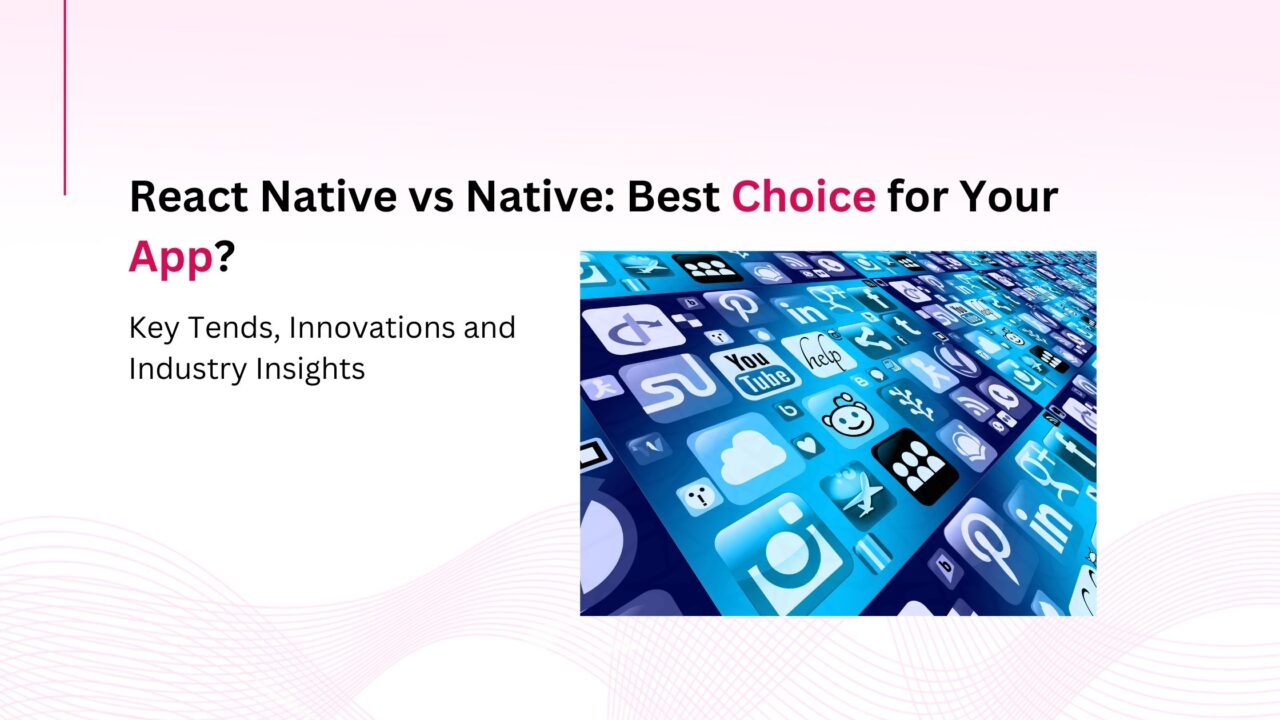In the dynamic world of mobile app development, choosing the right framework can make or break your product. With digital transformation becoming non-negotiable, businesses are often torn between building apps with React Native vs native development (Swift for iOS, Kotlin/Java for Android). Each approach has its pros and cons, and the right choice depends on your project’s goals, budget, timeline, and desired user experience.
This comprehensive guide compares React Native vs. Native development to help you make an informed decision and ensure your app delivers maximum ROI.
What Is React Native?
React Native is an open-source framework developed by Facebook that enables developers to build cross-platform mobile apps using JavaScript and React. It allows for a shared codebase across iOS and Android, making development faster and more cost-effective.
Popular apps built with React Native include Facebook, Instagram, Pinterest, Bloomberg, and Uber Eats—showcasing its scalability and reliability across industries.
What Is Native Development?
Native development involves building apps specifically for one platform using the language and tools provided by the platform’s owner. For iOS, this means Swift or Objective-C using Xcode; for Android, it’s Java or Kotlin using Android Studio. Native apps are known for high performance and a seamless user experience.
Apps like WhatsApp, Google Maps, Spotify, YouTube, and Snapchat are built natively—demonstrating native development’s strength in performance and deep hardware integration.
Understanding Cross-Platform vs Native: The Core Dilemma
Choosing between cross-platform and native development isn’t just a technical decision—it’s a strategic one. Cross-platform frameworks like React Native prioritize speed and cost-efficiency, enabling faster launches with a single team. For example, Uber Eats and Pinterest have used React Native to accelerate their development cycles.
In contrast, native development offers optimal performance and deeper customization, which is why apps like Spotify and Snapchat choose native frameworks to deliver high responsiveness, advanced animations, and better hardware access.
React Native Popularity: What Do the Numbers Say?
React Native is currently used by over 38% of mobile developers worldwide. It’s the go-to solution for many startups and enterprises, including Facebook, Walmart, and Tesla, because of its flexibility and time-saving capabilities.
Key Differences Between React Native and Native Development
| Feature | React Native | Native Development |
| Code Reusability | High (shared across platforms) | Low (separate codebases) |
| Performance | Near-native | Best-in-class |
| Development Speed | Faster (one team, one codebase) | Slower (platform-specific teams) |
| UI/UX | Good, but may lack some native feel | Excellent and fully optimized |
| Access to Native APIs | Limited or requires bridging | Full access |
| Community Support | Large and active | Strong but platform-specific |
| Cost Efficiency | More cost-effective | Higher due to multiple teams |
| Updates & Maintenance | Easier (single codebase) | Complex (platform-specific updates) |
Advantages of React Native
1. Faster Development Time
With React Native, developers can work with a single codebase that serves both iOS and Android platforms. This significantly cuts down on development time and reduces the resources needed, making it ideal for businesses working on tight deadlines or launching MVPs.
2. Cost-Effective Solution
Hiring one team to build for both platforms is a big cost-saver. React Native allows businesses to allocate resources efficiently without compromising on functionality or user experience.
3. Hot Reloading
React Native’s hot reloading lets developers see real-time results of the code they’re editing without needing to recompile the app. This boosts efficiency, minimizes downtime, and makes debugging smoother.
4. Strong Community & Plugin Support
The large developer community and wide range of third-party plugins mean there’s almost always a tool or solution available, which speeds up development and adds flexibility.
5. Backed by Tech Giants
React Native is supported and continuously improved by Meta (formerly Facebook). It’s also trusted by major companies such as Instagram, Airbnb, and Pinterest, which shows its scalability and dependability.
6. Cross-Platform Consistency
React Native ensures a consistent design and user experience across iOS and Android, which is crucial for brand identity and user retention.
7. Faster Time to Market
With reusable components and shorter development cycles, businesses can launch their apps faster and start receiving user feedback earlier.
Advantages of Native Development
1. Top-Tier Performance
Native apps are built specifically for one platform using optimized code, making them faster and more responsive. This is especially critical for apps that rely heavily on animations, data processing, or real-time interactions.
2. Optimal User Experience
Following platform-specific UI guidelines ensures that the app feels intuitive and natural to users, leading to better engagement and higher user satisfaction.
3. Access to All Native APIs
Native development allows full access to the platform’s APIs and hardware functionalities without the need for third-party modules or bridges, enabling advanced features and deeper integration.
4. Greater Security
Native apps benefit from platform-level security features and tighter control over code and data access, which is essential for apps handling sensitive information.
5. Long-Term Scalability
Native frameworks tend to be more stable and reliable for building large-scale apps, making them a better choice for enterprise-level solutions that require frequent updates and new features.
6. Advanced Customization
When you need to create complex UI animations or deeply customize app behavior, native development offers the control and precision that cross-platform tools may lack.
7. Better Integration with Hardware
If your app depends on features like the camera, GPS, sensors, or biometric authentication, native development ensures optimal performance and compatibility.
Developer Experience: Coding, Debugging & Tooling
React Native offers a smoother developer experience for those familiar with JavaScript and React. However, native platforms provide more powerful debugging and profiling tools specific to iOS and Android, making them suitable for complex development environments.
Testing & Debugging: React Native vs Native
React Native supports automated testing through tools like Jest and Detox, while native development benefits from platform-specific testing tools such as XCTest for iOS and Espresso for Android.
Performance Benchmark: Animation, API Access & Load Time
In performance-intensive applications like gaming or AR/VR, native development typically outperforms React Native. However, React Native performs adequately for most standard business applications.
Companies Using React Native and Native Development
- React Native: Facebook, Instagram, Bloomberg, Uber Eats, Pinterest
- Native Development: WhatsApp, Spotify, YouTube, Snapchat, Google Maps
When Should You Choose React Native?
If you’re:
- A startup with a limited budget
- Building an MVP (Minimum Viable Product)
- Releasing a content-based or simple app
- Targeting both iOS and Android users simultaneously
- Looking for a quicker launch to validate an idea
Example Use Case:
An e-learning startup wants to quickly launch an MVP for both platforms to test user engagement—React Native is the perfect fit.
When Should You Choose Native Development?
If you’re:
- Developing a performance-critical app (e.g., mobile games)
- Building a platform-specific product (e.g., Apple Watch app)
- Prioritizing security and UX
- Creating AR/VR or hardware-integrated applications
- Planning for a long-term, scalable enterprise app
Example Use Case:
A fintech company developing a highly secure mobile banking app should choose native development for its robust API access and performance.
Cost Comparison: React Native vs Native
| Factor | React Native App | Native App (iOS & Android) |
| Development Time | Shorter | Longer |
| Number of Developers | 1 cross-platform team | 2 separate platform teams |
| Maintenance Costs | Lower | Higher |
| Initial Cost | Lower | Higher |
Future of Mobile Development: Is React Native the Future?
React Native is continuously evolving with better performance, broader API access, and more community support. It is becoming a viable solution even for more sophisticated applications.
However, native development still leads in terms of performance, customization, and device-specific features. The future might lean toward hybrid approaches where React Native handles the majority, and native code covers complex features.
Conclusion
React Native and Native development each bring unique strengths to mobile app development. If you’re looking to build an app fast and economically, React Native may be the right choice. On the other hand, if performance, UX, and native feature access are paramount, native development is the way to go.
At Cosnet, we help businesses navigate these decisions with expert consultation and development services. Whether you need a sleek cross-platform MVP or a powerful native enterprise app, our team is ready to bring your vision to life.
Ready to build your next app?
Get in touch with Cosnet and let’s turn your idea into a top-performing mobile experience.

